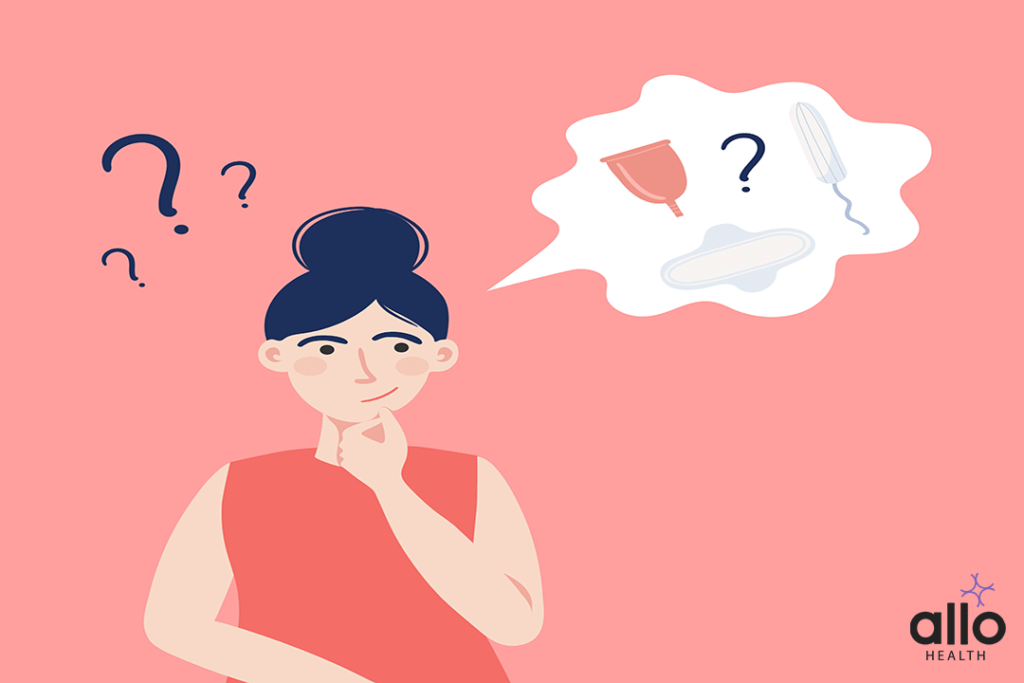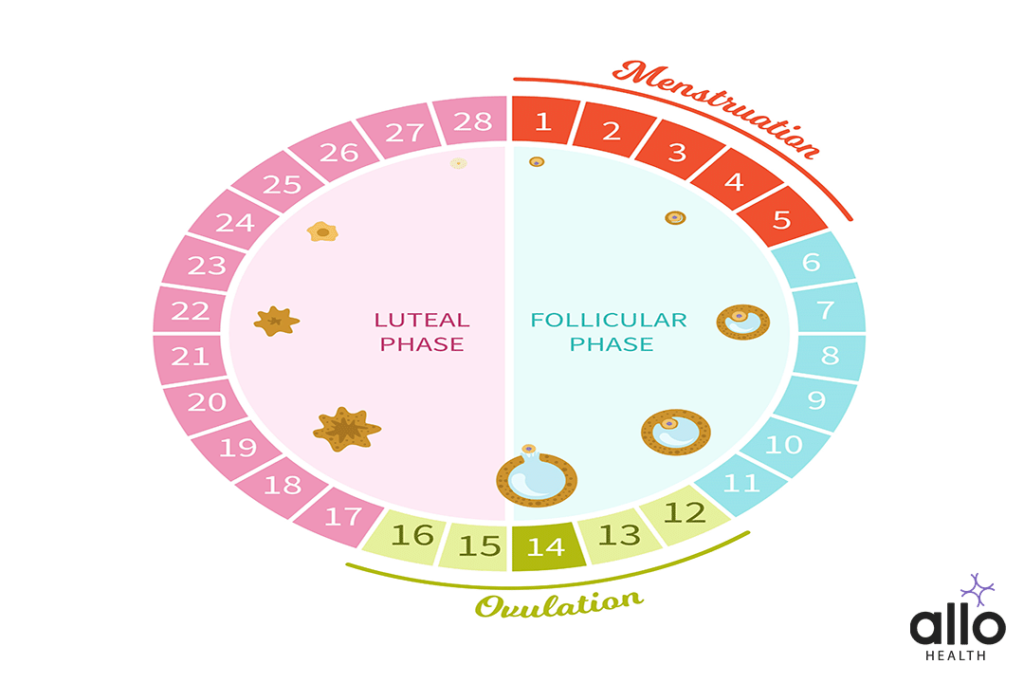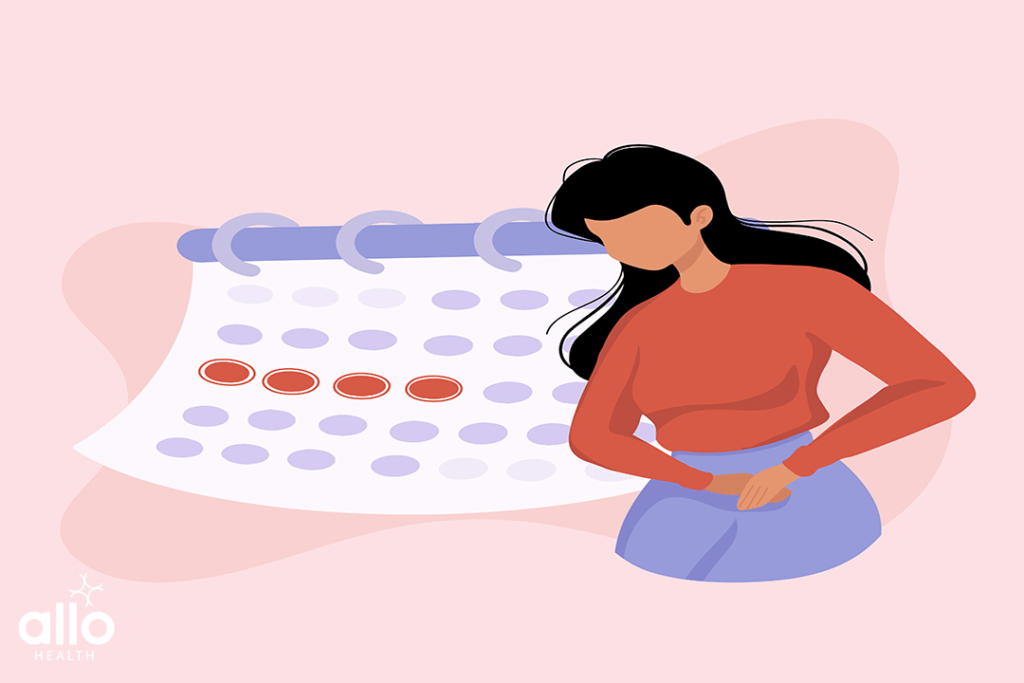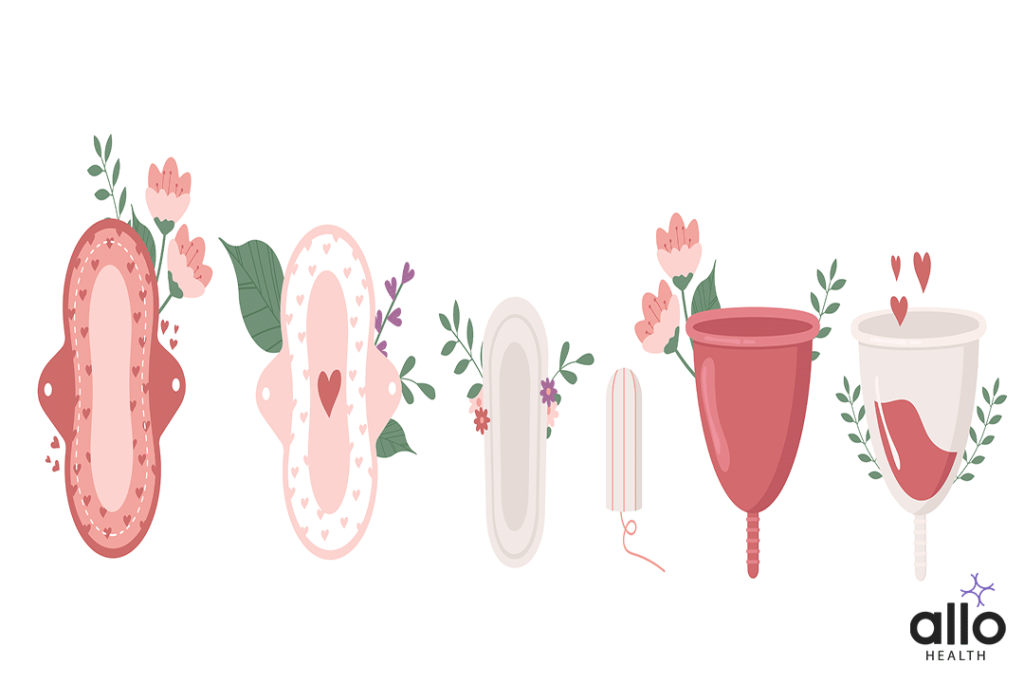Menstrual Health 101

Allo Health is dedicated to personalized well-being, offering support and trusted information tailored to individual health goals. The platform emphasizes human-generated content, led by a distinguished medical team of experts, including physicians and sexual health specialists. Their commitment to credibility involves rigorous fact-checking, authoritative research, and continuous updates to ensure accurate, up-to-date information. Allo Health's unique approach goes beyond conventional platforms, providing expert-led insights and a continuous commitment to excellence, with user feedback playing a crucial role in shaping the platform's authoritative voice.

Dr.Sanjana holds a MBBS degree from Vydehi Medical Institute and Research Centre, Bangalore. She has extensive experience working in numerous multispeciality hospitals and digital platforms. Her vast knowledge in the field of sexual wellness along with her ability to connect/empathise with her patients makes her guide patients to make informed decisions for themselves.

Anoush Gomes is a seasoned Content Writer with over 10 years of experience, specializing in various writing styles such as medical content, creative writing, storytelling, and research papers. Anoush embarked on a unique journey, starting with pre-medical studies at the Dante Aligheri Academy and the University of Miami, where she earned a Bachelor's degree with a major in Biology and a minor in Psychology. Having pursued medical school and completed clinicals, Anoush transitioned to the world of medical content writing, where her passion for both healthcare and writing converged. Her writing skills encompass persuasive, narrative, expository, and descriptive styles, making complex medical concepts accessible to diverse audiences. Beyond her professional endeavors, Anoush is a multi-faceted individual with a rich tapestry of interests. A writer, artist, poet, avid reader, certified nerd, and hopeful author, she finds inspiration in the intersection of creativity and science. Whether crafting engaging medical narratives or weaving captivating stories, Anoush combines her diverse background and writing expertise to deliver compelling content that resonates with diverse audiences.
Why This Was Upated?
Our experts continually monitor the health and wellness space, and we update our articles when new information became available.
Updated on 03 November, 2023
- Article was updated as part of our commitment to diversity, equity, and inclusion.

"The following blog article provides general information and insights on various topics. However, it is important to note that the information presented is not intended as professional advice in any specific field or area. The content of this blog is for general educational and informational purposes only.
Book consultation
The content should not be interpreted as endorsement, recommendation, or guarantee of any product, service, or information mentioned. Readers are solely responsible for the decisions and actions they take based on the information provided in this blog. It is essential to exercise individual judgment, critical thinking, and personal responsibility when applying or implementing any information or suggestions discussed in the blog."
"The following blog article provides general information and insights on various topics. However, it is important to note that the information presented is not intended as professional advice in any specific field or area. The content of this blog is for general educational and informational purposes only.
Book consultation
The content should not be interpreted as endorsement, recommendation, or guarantee of any product, service, or information mentioned. Readers are solely responsible for the decisions and actions they take based on the information provided in this blog. It is essential to exercise individual judgment, critical thinking, and personal responsibility when applying or implementing any information or suggestions discussed in the blog."
Menstrual Health And Hygiene
Every woman gets her period, which is a normal biological process. It is the shedding of the uterine lining that occurs approximately every 28 days. In order to maintain good reproductive health and avoid infections, women must practise good menstrual hygiene. In this blog, we will discuss menstrual health and hygiene from a medical perspective.
The Menstrual Cycle

The menstrual cycle is the monthly cycle of changes that occur in a woman’s body in preparation for pregnancy. The menstrual cycle is controlled by a complex interplay of hormones, and it is divided into four phases: the menstrual phase, the follicular phase, the ovulatory phase, and the luteal phase. Each phase is unique and important in its own way and understanding these phases can help women better understand their bodies and reproductive health.
Phase 1: Menstrual Phase
The menstrual phase is the first phase of the menstrual cycle and is also known as the bleeding phase. It starts on the first day of menstrual bleeding and lasts for an average of three to seven days. During this phase, the uterus sheds its inner lining, known as the endometrium, which is accompanied by bleeding.
The bleeding occurs as a result of the uterus contracting to expel the endometrial lining. Menstrual blood contains blood, mucus, and tissue from the uterus. On average, women lose between 30 and 80 ml of blood during each menstrual cycle.
Phase 2: Follicular Phase
The follicular phase is the second phase of the menstrual cycle and occurs immediately after the menstrual phase. This phase varies from women to women (eg: in a 28 day cycle, it is 14 days and in a 30 day cycle it is 16 days. The last 14 days of the cycle is always fixed) . During this phase, follicle-stimulating hormone (FSH) is released from the pituitary gland, which stimulates the growth of a number of follicles in the ovaries.
Each follicle contains an immature egg that is surrounded by cells that produce estrogen. As the follicles grow, they produce more estrogen, which stimulates the endometrium to thicken and prepare for possible pregnancy. The follicle that is most responsive to FSH becomes dominant and continues to grow, while the others degenerate.
The cervical mucus during the follicular phase is thin, watery, and it is easily stretchable between two fingers – it does not break on stretching – it is called ferning.
Phase 3: Ovulatory Phase
The ovulatory phase is the third phase of the menstrual cycle and usually occurs around day 14 in a 28-day cycle. During this phase, luteinizing hormone (LH) is released from the pituitary gland, causing the dominant follicle to rupture and release a mature egg. LH surge typically occurs 24-36 hours before ovulation. This process is known as ovulation.
Ovulation usually lasts for about 24 hours, and during this time, the egg travels through the fallopian tube towards the uterus. If the egg is not fertilized by sperm during this time (fertility span of the egg is 24 hours), it will die and be absorbed by the body.
The cervical mucus during the ovulatory phase is egg white, stretchy, and this is the most fertile period.
Phase 4: Luteal Phase
The luteal phase is the final phase of the menstrual cycle and occurs after ovulation. It is fixed in every female – last 14 days of the cycle and is characterized by the development of the corpus luteum. It is a progesterone predominant phase. The corpus luteum is formed from the remnants of the ruptured follicle and produces progesterone, which helps prepare the endometrium for implantation.
If the egg is fertilised, it will travel down the fallopian tube and implant in the endometrium, where it will develop into an embryo. If the egg is not fertilised, the corpus luteum will degenerate, causing a decrease in progesterone. This sudden dip in the progesterone is responsible for the shedding of the endometrium and the start of a new menstrual cycle.
The menstrual cycle is a complex process that involves the interplay of hormones and physiological changes in a woman’s body. Understanding the different phases of the menstrual cycle can help women better understand their bodies and reproductive health. By keeping track of their menstrual cycles, women can identify irregularities or potential concerns and seek medical advice if necessary.
The cervical mucus during the luteal phase is copious, and breaks on stretching. Ferning is absent in this phase.
Menstrual Hygiene

In order to maintain good hygienic practices and ward off infections, women should adhere to certain practices known as menstrual hygiene. Some of the essential practises include:
Use of Sanitary Products: There are several types of sanitary products available, including sanitary pads, tampons, menstrual cups, and period panties. Women should choose a product that suits their needs and change it regularly.
Washing Hands: Women should wash their hands before and after changing their sanitary products.
Proper Disposal: Used sanitary products should be disposed off in a bin and not flushed down the toilet.
Personal Hygiene: Women should maintain good personal hygienic practices during their menstrual cycle, including showering or bathing regularly.
Avoiding Irritants: Women should avoid using scented products or douching during their menstrual cycle, as this can cause irritation and increase the risk of infection.
Menstrual Disorders
Amenorrhea is a condition where a woman doesn’t have menstrual periods. It can be of two types: primary and secondary. Primary amenorrhea is when a female does not get her first menstrual cycle by the age of 16. Secondary amenorrhea is when a woman has had regular menstrual cycles before, but they stop for more than three months.
Causes of Amenorrhea
Stress induced anovulation (functional hypothalamic amenorrhea)
Undernutrition
Pregnancy
Hormonal imbalances
Menopause
Polycystic ovary syndrome (PCOS)
Pituitary tumor
Excessive exercise
Extreme weight loss or gain
Treatment of Amenorrhea
The treatment of amenorrhea depends on the underlying cause. For instance, if the cause is hormonal imbalances, medications such as birth control pills or hormone replacement therapy can be given to regulate the menstrual cycle.
Dysmenorrhea
Dysmenorrhea is a painful menstruation that occurs in the lower abdomen and pelvis may radiate to the lower back and thigh. It can be of two types: primary and secondary. Primary dysmenorrhea is caused by the contraction of the uterus (due to the prostaglandins) and is common in younger women. Secondary dysmenorrhea occurs due to an underlying medical condition.
Causes of Dysmenorrhea
Uterine fibroids
Endometriosis
Adenomyosis
Pelvic inflammatory disease (PID)
Intrauterine devices (IUDs)
Treatment of Dysmenorrhea
The treatment of dysmenorrhea depends on the underlying cause. Pain relief medications, such as mefenemic acid (meftal-spas) ibuprofen and naproxen, can be given to relieve pain. In severe cases, surgery may be required to remove the underlying condition.
Menorrhagia and Metrorrhagia
Menorrhagia is a condition where a woman experiences heavy bleeding during her menstrual period (more than 80ml). It can be caused by the following:
Causes of Menorrhagia
Hormonal imbalances
Uterine fibroids
Adenomyosis
Endometriosis
Blood clotting disorders
Polyps: Metrorrhagia refers to irregular bleeding (in between cycles) – this is commonly seen in those that have polyps.
Treatment of Menorrhagia
The treatment of menorrhagia depends on the underlying cause. Medications, such as birth control pills (OCP – oral contraceptive pills), can be given to regulate the menstrual cycle. In severe cases, surgery may be required to remove the underlying condition.
Polycystic Ovary Syndrome (PCOS)
Polycystic ovary syndrome (PCOS) is a hormonal disorder that affects women of reproductive age. Women with PCOS have high levels of androgens (male hormones) in their bodies, which can cause irregular menstrual cycles, weight gain, and infertility.
Causes of PCOS
Hormonal imbalances
Genetics
Insulin resistance – (not a primary cause but usually associated with pcos)
Treatment of PCOS
The treatment of PCOS depends on the symptoms. Medications, such as birth control pills and metformin, can be given to regulate the menstrual cycle and reduce insulin resistance. Weight loss through diet and exercise can also help manage the symptoms of PCOS.
There Is Nothing Taboo About Your Period

Menstrual Taboos
Menstruation is a natural biological process that occurs in the female reproductive system. However, in many societies, it is considered taboo, and menstruating women are often stigmatized and discriminated against. This is particularly true in India, where menstruation is still shrouded in myths and taboos.
In India, menstruation is seen as impure and dirty, and women are often considered to be “unclean” during their periods. This belief is deeply ingrained in Indian culture, and it affects the way women are treated during menstruation. For example, menstruating women are not allowed to enter places of worship, cook, or touch certain objects, such as pickles or sour foods. They are also not allowed to touch men or participate in certain social activities.
One of the primary reasons behind the taboos surrounding menstruation in India is the lack of education and awareness about menstruation. Many girls are not taught about menstruation until they experience it for the first time, which can be a traumatic experience. This lack of education also means that many girls and women are not aware of the importance of menstrual hygiene, which can lead to health concerns.
Another reason for the taboos surrounding menstruation in India is the patriarchal society, which views women as inferior to men. This mindset is reflected in the way women are treated during their periods. Menstruating women are often excluded from social gatherings and treated as if they are a burden. This reinforces the idea that women are inferior and that menstruation is something to be ashamed of.
Women in India can cope with the taboos surrounding menstruation by raising awareness about the issue and breaking the silence surrounding it. This can be done by talking openly about menstruation, educating others, and advocating for menstrual hygiene. There are also several organizations in India that are working to break the stigma surrounding menstruation and provide support to women who are affected by it.
It is also essential to promote menstrual hygiene in India. This can be done by providing girls and women with access to affordable and hygienic menstrual products, such as pads and tampons. It is also important to educate girls and women about the importance of menstrual hygiene and the dangers of using unclean materials, such as cloth or leaves, during their periods.
The taboos surrounding menstruation in India are deeply ingrained in the culture and affect the way women are treated during their periods. Education and awareness are essential to break the silence surrounding menstruation and promote menstrual hygiene. Menstrual taboos in India can be overcome by women by speaking out for change, educating others, and promoting menstrual hygiene.
How Do I Know What Menstrual Products Is Right For Me?

When it comes to managing your period, there are many options available for menstrual products. However, with so many different types of products on the market, it can be difficult to know which one is right for you.
Tampons
Tampons are a popular menstrual product that are inserted into the vagina to absorb menstrual fluid. They come in different absorbency levels, and are often made from a blend of cotton and rayon. Tampons can be a good option if you are looking for a discreet, low-maintenance option. However, they do require a bit of practice to use correctly, and can sometimes be uncomfortable if they are not inserted properly. It is also important to change your tampon every 4-8 hours to reduce the risk of toxic shock syndrome (TSS).
Pads
Pads are another common menstrual product that are worn on the outside of the body to absorb menstrual fluid. They come in different sizes and absorbency levels, and are often made from a blend of cotton and plastic. Pads are a good option if you prefer not to insert anything into your body, or if you have a heavier flow. However, they can sometimes feel bulky and uncomfortable, and may be visible through tight-fitting clothing.
Menstrual cups
Menstrual cups are a reusable menstrual product that are inserted into the vagina to collect menstrual fluid. They are typically made from medical-grade silicone or latex, and come in different sizes to fit different bodies. Menstrual cups are a good option if you are looking for a more sustainable option that can be used for several years. They can also be worn for up to 12 hours, which is longer than tampons or pads. However, they do require a bit of practice to use correctly, and may not be suitable for people with certain medical conditions, such as an IUD.
Period underwear
Period underwear is a newer menstrual product that is designed to be worn like regular underwear, but with built-in absorbency. They come in different absorbency levels, and are often made from a blend of cotton and spandex. Period underwear is a good option if you are looking for a comfortable, low-maintenance option that can be worn on its own or as backup to another menstrual product. However, they may not be suitable for people with a heavier flow, and may take longer to dry than other menstrual products.
How to Choose the Right Menstrual Product for You
Now that you know the different types of menstrual products available, here are some factors to consider when choosing the right one for you:
Flow
Consider how heavy your flow is, and choose a product with the appropriate absorbency level. If you have a heavier flow, you may want to consider a tampon or menstrual cup with a higher absorbency level, or using period underwear as backup.
Comfort
Think about what feels comfortable for you. Some people find tampons uncomfortable, while others prefer not to wear pads. If you are new to menstrual products, you may want to try different options to see what feels most comfortable for you.
Lifestyle
Consider your lifestyle and daily activities. For example, if you are very active, you may want to choose a product that is secure and comfortable during physical activity. If you travel frequently, you may want to choose a product that is easy to pack and carry with you.
Sustainability
If sustainability is important to you, you may want to consider a menstrual cup or period underwear, which are reusable and reduce waste.
How to Use Menstrual Products
How To Use A Tampon
To use a tampon, wash your hands and remove the tampon from its wrapper. Hold the tampon applicator between your thumb and middle finger, with the tip of the applicator pointing towards your body. Use your other hand to part your labia (the folds of skin around your vagina) and gently insert the tampon into your vagina. Once the tampon is fully inserted, use your finger to push the applicator inwards and release the tampon. Make sure the string is hanging outside your body, then wash your hands again. Change your tampon every 4-8 hours.
How To Use A Pad
To use a pad, remove it from its wrapper and remove the backing paper. Place the pad sticky side down onto the crotch of your underwear, making sure the front of the pad is at the front of your underwear. The adhesive should stick to the fabric of your underwear. Change your pad every 4-6 hours, or as needed.
How To Use A Menstrual Cup
To use a menstrual cup, wash your hands and fold the cup in half, then insert it into your vagina. Once the cup is inside, let it open up and form a seal against the walls of your vagina. Make sure the cup is fully opened and positioned correctly, then use your finger to check that the cup is properly sealed. To remove the cup, gently pull on the stem until you can reach the base of the cup, then pinch the base to release the seal and pull the cup out. Empty the cup into the toilet or sink, then rinse it with water before reinserting. You can wear a menstrual cup for up to 12 hours.
How To Use A Period Underwear
To use period underwear, simply wear them like regular underwear. Make sure you choose a pair with the appropriate absorbency level for your flow. Change your period underwear as needed throughout the day, and wash them according to the manufacturer’s instructions.
Choosing the right menstrual product for you comes down to your personal preferences and needs. Consider your flow, comfort, lifestyle, and sustainability preferences when making your choice. With proper use, any of these menstrual products can be an effective way to manage your period.
For women to maintain good reproductive health and prevent infections, menstrual hygiene is crucial. Women should practice good menstrual hygiene and seek medical help if they experience any menstrual disorders. By taking care of their menstrual health, women can ensure that they can lead a healthy and productive life.
Why Is Reproductive Health Education Important In India?
Reproductive health education is a crucial aspect of overall health education, especially in India. Reproductive health education encompasses various topics such as sexual health, family planning, contraception, sexually transmitted infections (STIs), and menstrual hygiene. In India, where cultural and societal norms often make discussions around sexuality and reproductive health taboo, it is essential to promote reproductive health education to create awareness and break the stigma around these concerns.
Here are some of the reasons why reproductive health education is vital in India:
Reducing maternal and infant mortality rates
India has one of the highest maternal mortality rates globally, with approximately 113 maternal deaths per 100,000 live births. The lack of knowledge and access to proper reproductive health care services contribute significantly to these numbers. Reproductive health education can educate women on the importance of prenatal care, safe delivery, and postnatal care to ensure both maternal and infant health. It can also educate individuals on the importance of family planning and contraception to prevent unplanned pregnancies and reduce the risk of maternal deaths.
Preventing and managing sexually transmitted infections (STIs)
India has a high prevalence of STIs, with an estimated 2.1 million new cases of HIV infections alone reported in 2019. Reproductive health education can help promote safe sex practices, such as the use of condoms, to prevent STIs. It can also educate individuals on the symptoms and treatment of STIs, which can help prevent the spread of the disease and promote early detection and treatment.
Empowering women
Reproductive health education can empower women by providing them with the knowledge and resources to make informed decisions about their reproductive health. It can educate women on their right to access reproductive health services and the importance of gender equality. Reproductive health education can also help break the stigma around menstruation and menstrual hygiene, which often hinders women’s ability to participate in social and economic activities.
Reducing the burden of population growth
India is the second-most populous country globally, with a population of over 1.3 billion people. Reproductive health education can educate individuals on the importance of family planning and contraception to prevent unplanned pregnancies and reduce the burden of population growth. This can also help reduce the strain on healthcare, education, and other resources, leading to better socio-economic development.
Addressing social and cultural taboos
In India, discussions around sexuality and reproductive health are often considered taboo, which can lead to misinformation and misunderstandings. Reproductive health education can help break the stigma around these concerns by providing accurate and scientific information on reproductive health. It can also promote open communication and discussion around these concerns, leading to better health outcomes and improved overall well-being.
Reproductive health education is crucial in India to promote better health outcomes, empower women, and break the stigma around sexuality and reproductive health. The government and civil society must work together to promote and implement reproductive health education programs that are inclusive, accessible, and culturally sensitive. By prioritizing reproductive health education, we can ensure that everyone has the knowledge and resources to make informed decisions about their reproductive health, leading to better health outcomes and improved quality of life for all.
Why Woman Need Adequate Access To Water?
Access to clean water is essential for everyone’s health, but it is particularly critical for women who menstruate. Unfortunately, millions of women around the world lack access to clean water, and this has significant impacts on their menstrual health.
Increased Risk of Infections
When women do not have access to clean water, they are more likely to use contaminated water to wash their hands, clean menstrual products, or even bathe. This can increase their risk of developing infections, including urinary tract infections, and bacterial vaginosis. Infections can cause discomfort, pain, and even lead to more severe health complications if left untreated.
Skin Irritation
Using dirty water to wash menstrual products or to clean the genital area can also cause skin irritation. Irritation can lead to rashes, itching, and discomfort. It is essential to use clean water to prevent skin irritation and reduce the risk of infection.
Limited Availability of Sanitary Products
In many areas where there is limited access to clean water, there is also limited availability of sanitary products. This means that women may be forced to use unhygienic materials, such as old rags, leaves, or even mud, to manage their periods. These materials can cause irritation, and they are not effective at preventing leaks. In addition, women may be embarrassed to seek help or ask for supplies, leading to missed school or work.
Impact on Mental Health
The lack of access to clean water and proper menstrual hygiene management can also have significant impacts on women’s mental health. Many women feel ashamed or embarrassed about their periods, and the additional stress of inadequate water or supplies can exacerbate these feelings. In addition, women who miss school or work due to menstruation may feel frustrated and helpless, leading to depression and anxiety.
Limited Mobility
In some areas, women must travel long distances to access clean water. This can be particularly challenging for women who are menstruating. Women may be reluctant to leave their homes during their periods, as they may not have access to sanitary products or clean water to wash their hands or clean menstrual products. This can limit their mobility and their ability to participate fully in their communities.
The lack of access to clean water has significant impacts on women’s menstrual health. Women who menstruate need access to clean water to maintain proper hygiene and prevent infections. They also need access to adequate sanitary products to manage their periods effectively. Addressing the water and sanitation needs of women is critical to ensuring their health, dignity, and overall well-being.
Why Practising Menstrual Hygiene In Schools Is Important?
Menstruation is a natural process that occurs in the female body, yet it is still considered a taboo in many parts of the world. Girls and women face several challenges during their menstrual cycles, such as menstrual pain, discomfort, and stigma. The lack of access to menstrual hygiene products, sanitation facilities, and awareness about menstrual hygiene practices is a significant concern, especially in schools.
It is essential to create an environment where girls can manage their menstrual health with dignity and ease.
Providing menstrual hygiene products
Schools should provide menstrual hygiene products like sanitary pads, tampons, and menstrual cups to girls. These products should be made available in school washrooms, so girls can access them easily during their periods. It is also important to ensure that these products are of good quality and are regularly restocked.
Providing adequate sanitation facilities
Schools should ensure that there are adequate sanitation facilities like toilets and handwashing facilities. These facilities should be clean and hygienic, and they should have proper disposal mechanisms for menstrual hygiene products. Separate toilets for girls and boys should be provided in schools, and they should be equipped with running water, soap, and toilet paper.
Creating awareness about menstrual hygiene
Schools should create awareness about menstrual hygiene among girls and boys. Girls should be taught about the menstrual cycle, how to manage their periods, and how to maintain hygiene during menstruation. Boys should also be educated about menstruation to remove the stigma associated with it. This will help create a supportive environment for girls to manage their menstrual health with dignity.
Providing menstrual leave
Schools should provide menstrual leave to girls who experience severe menstrual pain or discomfort. Menstrual leave will allow girls to take time off from school without affecting their academic performance. This will also help reduce the stigma associated with menstruation and promote gender equality.
Creating a supportive environment
Schools should create a supportive environment for girls during their menstrual cycles. Teachers and school staff should be understanding and supportive of girls who are menstruating. Girls should be encouraged to talk about their menstrual health without fear of being judged or stigmatized.
Engaging parents and the community
Schools should engage parents and the community in creating awareness about menstrual hygiene. Parents should be informed about the importance of menstrual hygiene and how they can support their daughters during their periods. The community can also be involved in providing menstrual hygiene products to schools and promoting menstrual hygiene awareness.
Menstrual hygiene is a critical issue that needs to be addressed in schools. Providing menstrual hygiene products, adequate hygiene facilities, creating awareness about menstrual hygiene behaviours, providing menstrual leave, creating a supportive environment, and engaging parents and the community are some ways in which menstrual hygiene can be improved in schools. By taking these steps, we can ensure that girls can manage their menstrual health with dignity and ease, and we can promote gender equality in schools.




































